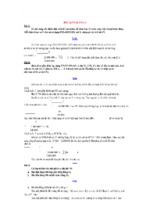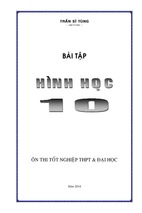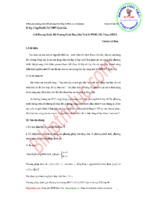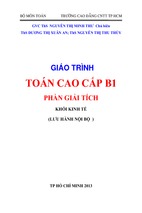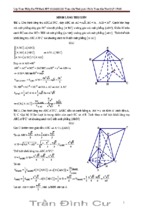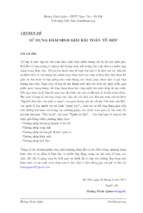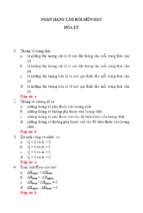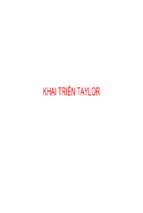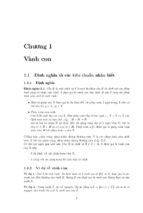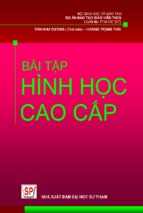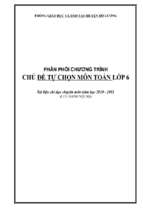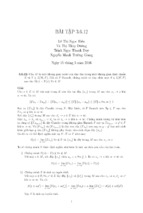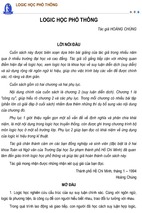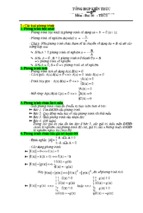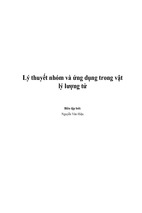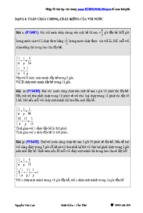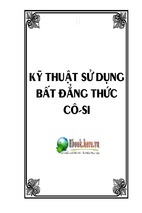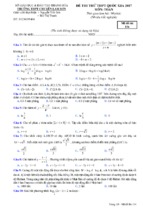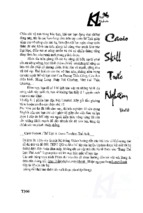This book contains 103 highly selected problems used in the training and testing of
the U.S. International Mathematical Olympiad (IMO) team. It is not a collection of
very difficult, impenetrable questions. Instead, the book gradually builds students’
trigonometric skills and techniques. The first chapter provides a comprehensive introduction to trigonometric functions, their relations and functional properties, and
their applications in the Euclidean plane and solid geometry. This chapter can serve
as a textbook for a course in trigonometry. This work aims to broaden students’
view of mathematics and better prepare them for possible participation in various
mathematical competitions. It provides in-depth enrichment in important areas of
trigonometry by reorganizing and enhancing problem-solving tactics and strategies.
The book further stimulates interest for the future study of mathematics.
About the Authors
Titu Andreescu received his BA, MS, and PhD from the West University
of Timisoara, Romania. The topic of his doctoral dissertation was "Research
on Diophantine Analysis and Applications". Titu served as director of the
MAA American Mathematics Competitions (1998-2003), coach of the USA
International Mathematical Olympiad Team (IMO) for 10 years (19932002), director of the Mathematical Olympiad Summer Program (19952002) and leader of the USA IMO Team (1995-2002). In 2002 Titu was
elected member of the IMO Advisory Board, the governing body of the
international competition. Titu received the Edyth May Sliffe Award for
Distinguished High School Mathematics Teaching from the MAA in 1994
and a "Certificate of Appreciation" from the president of the MAA in 1995
for his outstanding service as coach of the Mathematical Olympiad Summer
Program in preparing the US team for its perfect performance in Hong Kong
at the 1994 International Mathematical Olympiad.
Zuming Feng graduated with a PhD from Johns Hopkins University with
emphasis on Algebraic Number Theory and Elliptic Curves. He teaches at
Phillips Exeter Academy. He also served as a coach of the USA IMO team
(1997-2003), the deputy leader of the USA IMO Team (2000-2002), and an
assistant director of the USA Mathematical Olympiad Summer Program
(1999-2002). He is a member of the USA Mathematical Olympiad Committee since 1999, and has been the leader of the USA IMO team and the
academic director of the USA Mathematical Olympiad Summer Program
since 2003. He received the Edyth May Sliffe Award for Distinguished High
School Mathematics Teaching from the MAA in 1996 and 2002.
Titu Andreescu
Zuming Feng
103 Trigonometry Problems
From the Training of the USA IMO Team
Birkhäuser
Boston • Basel • Berlin
Titu Andreescu
University of Wisconsin
Department of Mathematical
and Computer Sciences
Whitewater, WI 53190
U.S.A.
Zuming Feng
Phillips Exeter Academy
Department of Mathematics
Exeter, NH 03833
U.S.A.
AMS Subject Classifications: Primary: 97U40, 00A05, 00A07, 51-XX; Secondary: 11L03, 26D05,
33B10, 42A05
Library of Congress Cataloging-in-Publication Data
Andreescu, Titu, 1956103 trigonometry problems : from the training of the USA IMO team / Titu Andreescu,
Zuming Feng.
p. cm.
Includes bibliographical references.
ISBN 0-8176-4334-6 (acid-free paper)
1. Trigonometry–Problems, exercises, etc. I. Title: One hundred and three trigonometry
problems. II. Feng, Zuming. III. Title.
QA537.A63 2004
516.24–dc22
ISBN 0-8176-4334-6
2004045073
Printed on acid-free paper.
Birkhäuser
©2005 Birkhäuser Boston
®
All rights reserved. This work may not be translated or copied in whole or in part without the written
permission of the publisher (Birkhäuser Boston, c/o Springer Science+Business Media Inc., Rights
and Permissions, 233 Spring Street, New York, NY 10013, USA), except for brief excerpts in
connection with reviews or scholarly analysis. Use in connection with any form of information
storage and retrieval, electronic adaptation, computer software, or by similar or dissimilar methodology now known or hereafter developed is forbidden.
The use in this publication of trade names, trademarks, service marks and similar terms, even if they
are not identified as such, is not to be taken as an expression of opinion as to whether or not they are
subject to proprietary rights.
Printed in the United States of America.
9 8 7 6 5 4 3 2 1
www.birkhauser.com
SPIN 10982723
Contents
Preface
vii
Acknowledgments
ix
Abbreviations and Notation
xi
1 Trigonometric Fundamentals
Definitions of Trigonometric Functions in Terms of Right Triangles
Think Within the Box
You’ve Got the Right Angle
Think Along the Unit Circle
Graphs of Trigonometric Functions
The Extended Law of Sines
Area and Ptolemy’s Theorem
Existence, Uniqueness, and Trigonometric Substitutions
Ceva’s Theorem
Think Outside the Box
Menelaus’s Theorem
The Law of Cosines
Stewart’s Theorem
Heron’s Formula and Brahmagupta’s Formula
Brocard Points
1
1
4
6
10
14
18
19
23
28
33
33
34
35
37
39
vi
2
Contents
Vectors
The Dot Product and the Vector Form of the Law of Cosines
The Cauchy–Schwarz Inequality
Radians and an Important Limit
Constructing Sinusoidal Curves with a Straightedge
Three Dimensional Coordinate Systems
Traveling on Earth
Where Are You?
De Moivre’s Formula
41
46
47
47
50
51
55
57
58
Introductory Problems
63
3 Advanced Problems
73
4
Solutions to Introductory Problems
83
5
Solutions to Advanced Problems
125
Glossary
199
Further Reading
211
Preface
This book contains 103 highly selected problems used in the training and testing of
the U.S. International Mathematical Olympiad (IMO) team. It is not a collection of
very difficult, impenetrable questions. Instead, the book gradually builds students’
trigonometric skills and techniques. The first chapter provides a comprehensive introduction to trigonometric functions, their relations and functional properties, and
their applications in the Euclidean plane and solid geometry. This chapter can serve
as a textbook for a course in trigonometry. This work aims to broaden students’
view of mathematics and better prepare them for possible participation in various
mathematical competitions. It provides in-depth enrichment in important areas of
trigonometry by reorganizing and enhancing problem-solving tactics and strategies.
The book further stimulates interest for the future study of mathematics.
In the United States of America, the selection process leading to participation in the
International Mathematical Olympiad (IMO) consists of a series of national contests
called the American Mathematics Contest 10 (AMC 10), the American Mathematics
Contest 12 (AMC 12), the American Invitational Mathematics Examination (AIME),
and the United States of America Mathematical Olympiad (USAMO). Participation
in the AIME and the USAMO is by invitation only, based on performance in the
preceding exams of the sequence. The Mathematical Olympiad Summer Program
(MOSP) is a four-week intensive training program for approximately 50 very promising students who have risen to the top in the American Mathematics Competitions.
The six students representing the United States of America in the IMO are selected on
the basis of their USAMO scores and further testing that takes place during MOSP.
viii
Preface
Throughout MOSP, full days of classes and extensive problem sets give students
thorough preparation in several important areas of mathematics. These topics include combinatorial arguments and identities, generating functions, graph theory,
recursive relations, sums and products, probability, number theory, polynomials,
functional equations, complex numbers in geometry, algorithmic proofs, combinatorial and advanced geometry, functional equations, and classical inequalities.
Olympiad-style exams consist of several challenging essay problems. Correct
solutions often require deep analysis and careful argument. Olympiad questions can
seem impenetrable to the novice, yet most can be solved with elementary high school
mathematics techniques, cleverly applied.
Here is some advice for students who attempt the problems that follow.
• Take your time! Very few contestants can solve all the given problems.
• Try to make connections between problems. An important theme of this work
is that all important techniques and ideas featured in the book appear more
than once!
• Olympiad problems don’t “crack” immediately. Be patient. Try different approaches. Experiment with simple cases. In some cases, working backwards
from the desired result is helpful.
• Even if you can solve a problem, do read the solutions. They may contain
some ideas that did not occur in your solutions, and they may discuss strategic
and tactical approaches that can be used elsewhere. The solutions are also
models of elegant presentation that you should emulate, but they often obscure
the tortuous process of investigation, false starts, inspiration, and attention to
detail that led to them. When you read the solutions, try to reconstruct the
thinking that went into them. Ask yourself, “What were the key ideas? How
can I apply these ideas further?”
• Go back to the original problem later, and see whether you can solve it in a
different way. Many of the problems have multiple solutions, but not all are
outlined here.
• Meaningful problem-solving takes practice. Don’t get discouraged if you have
trouble at first. For additional practice, use the books on the reading list.
Acknowledgments
Thanks to Dorin Andrica and Avanti Athreya, who helped proofread the original
manuscript. Dorin provided acute mathematical ideas that improved the flavor of
this book, while Avanti made important contributions to the final structure of the
book. Thanks to David Kramer, who copyedited the second draft. He made a number
of corrections and improvements. Thanks to Po-Ling Loh, Yingyu Gao, and Kenne
Hon, who helped proofread the later versions of the manuscript.
Many of the ideas of the first chapter are inspired by the Math 2 and Math 3 teaching
materials from the Phillips Exeter Academy. We give our deepest appreciation to the
authors of the materials, especially to Richard Parris and Szczesny “Jerzy” Kaminski.
Many problems are either inspired by or adapted from mathematical contests in
different countries and from the following journals:
• High-School Mathematics, China
• Revista Matematicǎ Timişoara, Romania
We did our best to cite all the original sources of the problems in the solution section. We express our deepest appreciation to the original proposers of the problems.
Abbreviations and Notation
Abbreviations
AHSME
AIME
AMC10
AMC12
APMC
ARML
IMO
USAMO
MOSP
Putnam
St. Petersburg
American High School Mathematics Examination
American Invitational Mathematics Examination
American Mathematics Contest 10
American Mathematics Contest 12,
which replaces AHSME
Austrian–Polish Mathematics Competition
American Regional Mathematics League
International Mathematical Olympiad
United States of America Mathematical Olympiad
Mathematical Olympiad Summer Program
The William Lowell Putnam Mathematical Competition
St. Petersburg (Leningrad) Mathematical Olympiad
xii
Abbreviations and Notation
Notation for Numerical Sets and Fields
Z
Zn
N
N0
Q
Q+
Q0
Qn
R
R+
R0
Rn
C
[x n ](p(x))
the set of integers
the set of integers modulo n
the set of positive integers
the set of nonnegative integers
the set of rational numbers
the set of positive rational numbers
the set of nonnegative rational numbers
the set of n-tuples of rational numbers
the set of real numbers
the set of positive real numbers
the set of nonnegative real numbers
the set of n-tuples of real numbers
the set of complex numbers
the coefficient of the term x n in the polynomial p(x)
Notation for Sets, Logic, and Geometry
|A|
A⊂B
A⊆B
A\B
A∩B
A∪B
a∈A
a, b, c
A, B, C
R, r
[F]
[ABC]
|BC|
�
AB
the number of elements in the set A
A is a proper subset of B
A is a subset of B
A without B (set difference)
the intersection of sets A and B
the union of sets A and B
the element a belongs to the set A
lengths of sides BC, CA, AB of triangle ABC
angles � CAB, � ABC, � BCA of triangle ABC
circumradius and inradius of triangle ABC
area of region F
area of triangle ABC
length of line segment BC
the arc of a circle between points A and B
103 Trigonometry Problems
1
Trigonometric Fundamentals
Definitions of Trigonometric Functions in Terms of Right
Triangles
Let S and T be two sets. A function (or mapping or map) f from S to T (written
as f : S → T ) assigns to each s ∈ S exactly one element t ∈ T (written f (s) = t);
t is the image of s. For S � ⊆ S, let f (S � ) (the image of S � ) denote the set of images
of s ∈ S � under f . The set S is called the domain of f , and f (S) is the range of f .
For an angle θ (Greek “theta") between 0◦ and 90◦ , we define trigonometric
functions to describe the size of the angle. Let rays OA and OB form angle θ (see
Figure 1.1). Choose point P on ray OA. Let Q be the foot (that is, the bottom) of
the perpendicular line segment from P to the ray OB. Then we define the sine (sin),
cosine (cos), tangent (tan), cotangent (cot), cosecant (csc), and secant (sec) functions
as follows, where |P Q| denotes the length of the line segment P Q:
|P Q|
,
|OP |
|OQ|
cos θ =
,
|OP |
|P Q|
,
tan θ =
|OQ|
sin θ =
|OP |
,
|P Q|
|OP |
sec θ =
,
|OQ|
|OQ|
cot θ =
.
|P Q|
csc θ =
2
103 Trigonometry Problems
First we need to show that these functions are well defined; that is, they only depends
on the size of θ, but not the choice of P . Let P1 be another point lying on ray OA,
and let Q1 be the foot of perpendicular from P1 to ray OB. (By the way, “P sub
1" is how P1 is usually read.) Then it is clear that right triangles OP Q and OP1 Q1
|P Q|
|P1 Q1 |
are similar, and hence pairs of corresponding ratios, such as |OP
| and |OP1 | , are all
equal. Therefore, all the trigonometric functions are indeed well defined.
A
P1
P
O
Q
B
Q1
Figure 1.1.
By the above definitions, it is not difficult to see that sin θ, cos θ, and tan θ are
the reciprocals of csc θ, sec θ, and cot θ, respectively. Hence for most purposes, it is
enough to consider sin θ, cos θ, and tan θ. It is also not difficult to see that
sin θ
cos θ
= tan θ and
= cot θ.
cos θ
sin θ
By convention, in triangle ABC, we let a, b, c denote the lengths of sides BC, CA,
and AB, and let � A, � B, and � C denote the angles CAB, ABC, and BCA. Now,
consider a right triangle ABC with � C = 90◦ (Figure 1.2).
A
c
b
B
a
C
Figure 1.2.
For abbreviation, we write sin A for sin � A. We have
b
a
cos A = ,
tan A =
sin A = ,
c
c
b
a
sin B = ,
cos B = ,
tan B =
c
c
a
;
b
b
;
a
1. Trigonometric Fundamentals
and
a = c sin A,
b = c sin B,
c = a csc A,
a = c cos B,
b = c cos A,
c = a sec B,
a = b tan A;
b = a tan B;
c = b csc B,
3
c = b sec A.
It is then not difficult to see that if A and B are two angles with 0◦ < A, B < 90◦ and
A+B = 90◦ , then sin A = cos B, cos A = sin B, tan A = cot B, and cot A = tan B.
In the right triangle ABC, we have a 2 + b2 = c2 . It follows that
a2
b2
+
= 1.
c2
c2
(sin A)2 + (cos A)2 =
It can be confusing to write (sin A)2 as sin A2 . (Why?) For abbreviation, we write
(sin A)2 as sin2 A. We have shown that for 0◦ < A < 90◦ ,
sin2 A + cos2 A = 1.
Dividing both sides of the above equation by sin2 A gives
1 + cot 2 A = csc2 A,
or
csc2 A − cot 2 A = 1.
or
sec2 A − tan2 A = 1.
Similarly, we can obtain
tan2 A + 1 = sec2 A,
Now we consider a few special angles.
(Figure 1.3,
In triangle ABC, suppose � A = � B = 45◦ , and hence |AC| = |BC|
√
2
a
1
2
2
2
2
◦
left). Then c = a + b = 2a , and so sin 45 = sin A = c = √ = 2 . Likewise,
we have cos 45◦ =
√
2
2
2
and tan 45◦ = cot 45◦ = 1.
B
A
B
C
A
C
D
Figure 1.3.
In triangle ABC, suppose � A = 60◦ and � B = 30◦ (Figure 1.3, right). We
reflect A across line BC to point D. By symmetry, � D = 60◦ , so triangle ABD
is equilateral. Hence, |AD| = |AB| and |AC| = |AD|
2 . Because ABC is a right
4
103 Trigonometry Problems
triangle, |AB|2 = |AC|2 + |BC|2 . So we have |BC|2 = |AB|2 −
√
√
3|AB|
. It follows that sin 60◦ = cos 30◦ = 23 ,
2
√
√
cot 60◦ = 33 , and tan 60◦ = cot 30◦ = 3.
or |BC| =
|AB|2
4
sin 30◦ =
3|AB|2
4 ,
◦
cos 60 = 21 ,
=
tan 30◦ =
We provide one exercise for the reader to practice with right-triangle trigonometric
functions. In triangle ABC (see Figure 1.4), � BCA = 90◦ , and D is the foot of
the perpendicular line segment from C to segment AB. Given that |AB| = x and
� A = θ, express all the lengths of the segments in Figure 1.4 in terms of x and θ.
A
D
B
C
Figure 1.4.
Think Within the Box
For two angles α (Greek “alpha") and β (Greek “beta") with 0◦ < α, β, α + β <
90◦ , it is not difficult to note that the trigonometric functions do not satisfy the
additive distributive law; that is, identities such as sin(α + β) = sin α + sin β and
cos(α + β) = cos α + cos β are not true. For example, setting α = β = 30◦ , we have
√
cos(α + β) = cos 60◦ = 21 , which is not equal to cos α + cos β = 2 cos 30◦ = 3.
Naturally, we might ask ourselves questions such as how sin α, sin β, and sin(α + β)
relate to one another.
Consider the diagram of Figure 1.5. Let DEF be a right triangle with � DEF =
90◦ , � F DE = β, and |DF | = 1 inscribed in the rectangle ABCD. (This can
always be done in the following way. Construct line �1 passing through D outside
of triangle DEF such that lines �1 and DE form an acute angle congruent to α.
Construct line �2 passing through D and perpendicular to line �1 . Then A is the foot
of the perpendicular from E to line �1 , and C the foot of the perpendicular from F
to �2 . Point B is the intersection of lines AE and CF .)
1. Trigonometric Fundamentals
E
A
B
a
a+b
a
5
F
b
D
C
Figure 1.5.
We compute the lengths of the segments inside this rectangle. In triangle DEF ,
we have |DE| = |DF | · cos β = cos β and |EF | = |DF | · sin β = sin β. In triangle
ADE, |AD| = |DE| · cos α = cos α cos β and |AE| = |DE| · sin α = sin α cos β.
Because � DEF = 90◦ , it follows that � AED + � BEF = 90◦ = � AED + � ADE,
and so � BEF = � ADE = α. (Alternatively, one may observe that right triangles
ADE and BEF are similar to each other.) In triangle BEF , we have |BE| =
|EF | · cos α = cos α sin β and |BF | = |EF | · sin α = sin α sin β. Since AD � BC,
� DF C = � ADF = α + β. In right triangle CDF , |CD| = |DF | · sin(α + β) =
sin(α + β) and |CF | = |DF | · cos(α + β) = cos(α + β).
From the above, we conclude that
cos α cos β = |AD| = |BC| = |BF | + |F C| = sin α sin β + cos(α + β),
implying that
cos(α + β) = cos α cos β − sin α sin β.
Similarly, we have
sin(α + β) = |CD| = |AB| = |AE| + |EB| = sin α cos β + cos α sin β;
that is,
sin(α + β) = sin α cos β + cos α sin β.
By the definition of the tangent function, we obtain
tan(α + β) =
=
sin(α + β)
sin α cos β + cos α sin β
=
cos(α + β)
cos α cos β − sin α sin β
sin β
cos β
sin α sin β
cos α cos β
sin α
cos α
1−
+
=
tan α + tan β
.
1 − tan α tan β
We have thus proven the addition formulas for the sine, cosine, and tangent functions
for angles in a restricted interval. In a similar way, we can develop an addition formula
for the cotangent function. We leave it as an exercise.
- Xem thêm -

